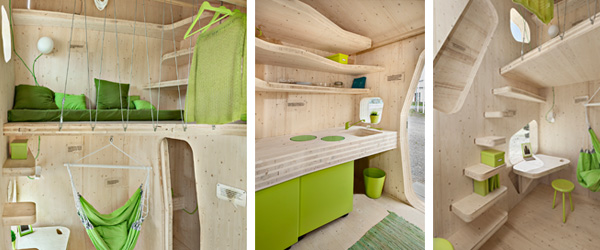Due to shows like, Tiny House Nation, Tiny House Builders and Tiny House Hunters, the tiny house movement seems to be all the rage right now. As storage geek, I’m fascinated by the design of tiny houses. I love to see the creative use of space and the multi-function features inside these homes. With its low cost, small footprint, and energy efficiency, the thought of being free from mortgages and high living costs is appealing but it comes with what can been seen as a lot of downsides (where exactly do you park a house??).
In a country where the population is used to a lot of space and having a lot of stuff, I’m not sure the tiny housing market is going to take over the U.S. suburbs anytime soon. However, there is a segment of the population that these units are perfect for: college students. An architect in Sweden is solving a very real problem on college campuses with the Studentboende: A student unit.

Tengbom Architects in Sweden has designed a living quarters for students at the University of Lund that is 10 square meters in size (that’s about 100 square feet for all you Americans out there). These economically friendly, affordable units were designed to solve a very serious space issue on Sweden’s campuses. Materials were chosen to help minimize cost and reduce student’s carbon footprint. The units save students up to 50% in rent annually and accomplish the university’s main goal: get more students into less space at a lower cost.
While it doesn’t seem like US colleges are hurting for space to build student housing, students are hurting when it comes to the cost of attending a four-year university. On average, tuition at a private four-year college can set you back about $32,000 a year, while a public institution is about $9,500. This doesn’t include room and board which can run anywhere between $7k-$9k for four years. If the “tiny dorm” movement can save a student up to $4,500, I think it’s something worth considering.
At Patterson Pope we’ve been thinking about space differently for a long time. We’ve had to. Architects don’t like to design storage spaces and clients don’t like to pay for them. Storage space = cost. Combine the cost of the square footage and the supplies that go into it and you’ve pretty much got yourself some decent overhead.
Our goal for our customers has been the same as the University of Lund, get more stuff into less space at a lower cost. It’s exciting to see this theory expand to not just stuff but living spaces. The benefit for the students and the universities that start thinking this way could be astronomical. It could potentially allow students who couldn’t normally afford to go away to college a chance at an education. It could also ease the student loan burden on those who are in debt tens of thousands of dollars the day they receive their diploma.










